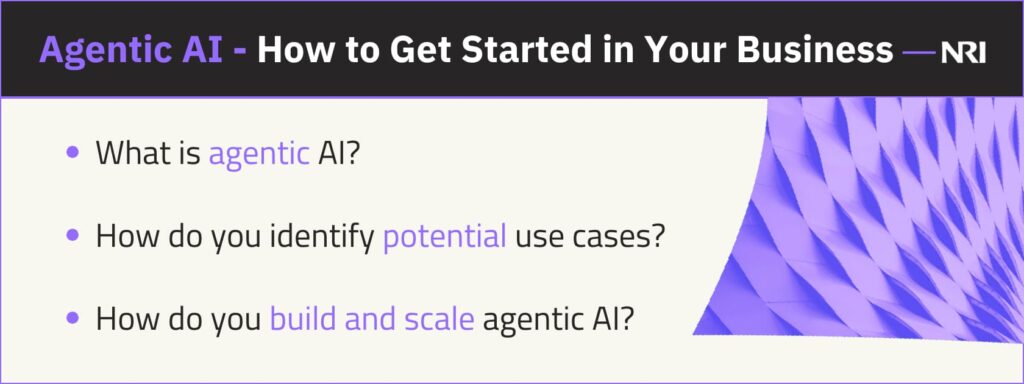Unlock new possibilities with this transformative technology.

Agentic artificial intelligence (AI) is the next frontier in business automation and intelligence. Unlike previous generations of AI systems that required explicit instructions and constant supervision, agentic AI can navigate complex workflows, make smarter decisions, and execute actions with minimal human oversight.
For IT professionals in large enterprises, understanding how to implement this powerful technology strategically could mean the difference between leading industry innovation and falling behind.
This guide provides a high-level roadmap for identifying opportunities, choosing the right platforms, and ensuring security and governance as you integrate Agentic AI into your organization. From proof-of-concept to production, this is your blueprint for unlocking intelligent automation. Let’s dive in!
Understanding Agentic AI in the Enterprise
Agentic AI is a high-level reasoning AI system that acts autonomously. It analyzes problems based on context and objectives, then develops and executes an optimum solution.
Key characteristics of agentic AI include:
- Autonomy: Executing tasks without constant human oversight.
- Adaptability: Adjusting behavior in response to changing conditions and new information.
- Complex Reasoning: Handling multi-step problems with high accuracy.
- Learning Capability: Continuously refining performance through each operational cycle based on feedback from each interaction.
- Goal orientation: Unlike simpler AI that responds to specific queries, agentic systems focus on achieving defined business outcomes through whatever appropriate pathways they discover.
So, how does agentic AI differ from traditional and generative AI?
Traditional AI automates repetitive tasks using predefined rules. In other words, a deterministic system thrives where processes are well-defined. However, this deterministic nature introduces rigidity, making it impossible to adapt to novel situations or make nuanced decisions in complex contexts.
Similarly, while generative AI (GenAI) has remarkable content creation and response generation capabilities, it only responds to specific prompts rather than proactively pursuing business objectives. It lacks the autonomous goal-seeking behavior characteristic of truly agentic systems.
Put differently, agentic AI represents the next level of AI capabilities.
Real-world applications demonstrate the value of these systems.
For example:
- Tesla’s FSD v12 software uses agentic AI for self-driving, allowing vehicles to handle traffic, turns, and obstacles autonomously, learning and adapting like a human driver.
- Microsoft Copilot has agentic AI capabilities that allow enterprises to perform specific, often complex, tasks by connecting their organizational data and automating workflows. These agents can handle routine activities such as data entry, scheduling, report generation, and even more advanced tasks like sales pipeline management, research, and analytics. Companies can use prebuilt agents, deploy agents created by others, or build custom agents tailored to their unique business needs using Microsoft Copilot Studio’s no-code/low-code environment.
- According to Ernst & Young, many companies also leverage agentic AI for supply chain optimization, to manage routes and inventory levels, and to improve logistics efficiency.
No matter your industry, there’s likely a place for agentic AI.
Identifying the Right Business Opportunities
Repeatable, decision-heavy processes are most likely to benefit from agentic AI. Therefore, start by pinpointing these. For example, what workflows occur frequently but have enough variability that rule-based automation would struggle? Which ones require evaluating multiple factors simultaneously and more nuanced decision-making?
Once you’ve identified the pain points that agentic AI can help solve, it’s time to consider the return on investment (ROI).
- What will it cost to implement a particular solution?
- What are the ongoing expenses to keep it operational?
- What are the change management needs?
- Do the benefits (e.g., increased productivity, efficiency, and cost savings) justify investment?
Engaging business stakeholders from the start is the best way to ensure the initiative aligns with the organization’s broader strategic objectives. Collaborate to map current processes end-to-end, then work your way towards identifying and prioritizing opportunities for enhancement through agentic AI. Also, define what success looks like and the metrics you’ll use. At the same time, ensure everyone is on the same page about the capabilities and limitations of agentic AI’s.
Setting Up the Technology Foundation
A robust data infrastructure and thoughtful integration approach are needed for successful AI implementation.
Here’s where to start:
- Inventory your data sources, assess quality and completeness, clean up, and establish strategic pipelines for timely access.
- Build an integrated architecture where agentic systems can interact with existing enterprise applications, data repositories, and other systems.
- Leverage edge computing to support agentic AI’s low-latency data processing and analysis requirements.
- Ensure security, governance, and compliance are baked into your solution from day one.
- Define clear boundaries for what actions agentic systems can take autonomously and what requires human adjudication, and set appropriate guardrails to prevent unintended consequences. Additionally, every decision and action must be logged with sufficient context to understand the reasoning behind them.
Azure OpenAI and Microsoft Copilot Studio are great platforms for building and deploying agentic AI.
Azure OpenAI offers REST API access to state-of-the-art models like GPT-4, which you can fine-tune to match agentic AI capabilities to your business needs. Built on Microsoft Azure, the service benefits from Azure’s cloud infrastructure for scalable deployment, integrated security features, and compliance with industry standards
Microsoft Copilot Studio offers the orchestration layer and low-code environment for easily building, customizing, and deploying the models. It allows you to create sophisticated agent workflows by connecting to various data sources via prebuilt or custom plugins, giving you more control.
To learn more about the Microsoft AI portfolio, read our detailed blog.
Building and Scaling Agentic Solutions
Start Small: Pilot Programs and Low-Risk Experiments
A measured approach is essential when introducing agentic AI to the enterprise. Start with a tightly scoped proof-of-concept. Test the agentic AI prototype in a sandbox environment, then initially deploy it to limited user groups or non-critical business processes.
Feedback Loops, Human-in-the-Loop Design, and Iteration
Establish mechanisms to collect feedback from human supervisors and end-users interacting with the system and processes for incorporating feedback into system improvements, whether through model retraining, rule refinements, or architectural adjustments. Use A/B testing to evaluate proposed changes before implementation.
Scaling Strategies and Aligning with Enterprise Architecture
Once you see desired results, it’s time for enterprise-wide adoption—this, too, should be executed gradually through a phased approach. Ensure your agentic AI solution seamlessly integrates with your enterprise architecture and that there is enough scalability to accommodate future needs. A hybrid cloud infrastructure can provide the necessary room for growth.
Preparing IT for the Next Generation of Work
As agentic AI transforms enterprise operations, IT departments must ensure the governance structures continue to cover all bases. At the beginning, there will likely be skill gaps. The role of IT is to lead the organizational change management process by providing comprehensive training so that everyone understands and quickly adapts to working alongside autonomous systems, because that is the future: Human-AI collaboration.
NRI can help you operationalize agentic AI within your enterprise by tapping the benefits of the Microsoft platform. No matter where you are with your AI maturity, we will meet you there and chart an optimal path to thrive in the new world.
Let’s talk! Schedule a custom AI assessment and move forward informed and in control.



